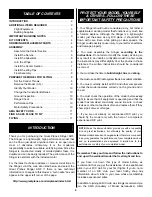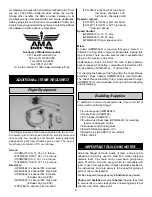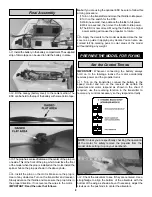
Until you have the Slinger properly trimmed for level flight,
we recommend having an assistant hand-launch the model
instead of launching it yourself.
Turn on the transmitter and plug the battery into the speed
control. Turn on the receiver by following the instructions that
came with your speed control. Secure the canopy in place.
IMPORTANT: Confirm that the transmitter operates the controls
properly by moving the sticks and watching the surfaces respond.
When ready to launch, the assistant should hold the Slinger
by the leading edges of the wing, with the model in front of
him and pointed into the wind. With the pilot
(that would be
you!) standing behind the plane, fully advance the throttle to
start the motor. As soon as the motor is at full power, the
hand launcher should gently push the plane into the air at a
level or slightly nose-up attitude. Be certain the model is
being launched into the wind and be immediately ready to
make corrections to keep the airplane flying straight, level
and into the wind.
When the model has gained adequate flying speed under
its own power, gently pull the elevator stick back until the
airplane starts a gradual climb. Many beginners tend to pull
too hard causing the model to stall, so be gentle on the
elevator and don’t panic. If you do pull too hard and you
notice the model losing speed, release the elevator stick
and allow the model to regain airspeed.
Continue a gradual climb and establish a gentle turn (away
from yourself and others) until the airplane reaches an
altitude of 75 to 100 feet.
Flight
The main purpose of the first few flights is to learn how the
model behaves and to adjust the trims for level flight. After the
model has climbed to a safe altitude reduce the throttle slightly
to slow the model, yet maintain altitude. The Slinger should fly
well and maintain adequate airspeed at about 3/4 throttle.
Adjust the elevator trim so the model flies level at the
throttle setting you are using. Adjust the aileron trim to level
the wings. It may take a few minutes to get the trims
adjusted, but this should be your first priority once at a
comfortable altitude. Continue to fly around, executing turns
and making mental notes (or having your assistant take
notes for you) of what additional adjustments or C.G.
changes may be required to fine tune the model so it flies
the way you like.
Landing
Begin the landing approach by flying downwind at an
altitude of approximately 20 feet [6 meters]. When the
airplane is approximately 50 to 100 feet [15 to 30 meters]
past you, gradually reduce power and make the “final” 180-
degree turn into the wind aligning the airplane with the
runway or landing area. Do not dive the airplane, as it will
pick up too much speed. Instead, allow the airplane to
establish a gradual descent. Concentrate on keeping it
heading into the wind toward the runway. When the plane
reaches an altitude of about 3 feet [1 meter], gently apply a
little “up elevator” to level the plane, but be careful as too
much up elevator will cause it to stall. While holding a slight
amount of up elevator the airplane will slow and descend as
it loses flying speed, thus touching-down on the runway.
Until you are able to accurately judge how far the Slinger can
glide, it may be helpful to reserve some battery power to run
the motor so the plane can be flown back to the runway.
Best of luck and happy flying!
This model belongs to:
Name
Address
City, State Zip
Phone number
AMA number
Identification Tag
Use this tag or photocopy it and use the copy.
Please fill in the indicated information and place
the tag in your model.
Printed in China






























